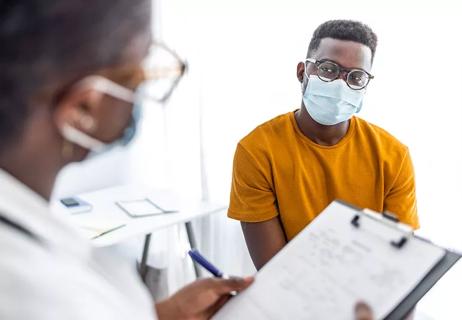This alternative brain-body therapy focuses on unlocking pent-up feelings, memories and tension that may be stuck in your brain and body

Stress and tension have a way of building up in our bodies. Over time, they can take a mental and physical toll on our overall health and wellness. But when it comes to deeper psychological traumas and traumatic events, we’re often left feeling like we’re stuck or spinning our wheels if we’re not able to process and heal from them.
Advertisement
Cleveland Clinic is a non-profit academic medical center. Advertising on our site helps support our mission. We do not endorse non-Cleveland Clinic products or services. Policy
That’s where brainspotting comes in. As a fairly new alternative therapy, brainspotting uses spots in a person’s field of vision to unlock pent-up trauma and suppressed memories and feelings associated with traumatic events or uncomfortable situations. By focusing on these brainspots, a person may be able to reprocess these events, heal from them and move past them perhaps faster than other treatments.
Registered psychotherapist Natacha Duke, MA, RP, explains how brainspotting works, the theory behind the alternative therapy and what you can expect from a brainspotting session.
Brainspotting is a relatively new brain-body alternative therapy that uses eye positioning to process difficult emotions and unresolved traumatic experiences. This therapy was discovered in 2003 by David Grand, PhD, while Dr. Grand was working with eye movement desensitization and reprocessing (EMDR) therapy. EMDR involves side-to-side eye movements in combination with talk therapy as a way of reprocessing traumatic events and replacing negative feelings or thoughts with more positive ones.
But brainspotting is different from EMDR because there’s very little to no talk therapy involved. Instead of rapidly moving your eyes from side to side in a very structured format, with brainspotting, you’re slowly following a pointer held by your therapist to locate a specific spot in your field of vision called a brainspot.
Advertisement
“As the therapist moves the pointer, the therapist would ask you to notice where your physical body sensations are, where your thoughts and your emotions are becoming the hottest or the most intense for you,” explains Duke. “And then, they would move the pointer up and down from there in order to locate the brainspot, which is the area of focus that causes the most hot spots of hot emotions and hot spots of physical body feeling.”
Brainspotting is more focused on somatic feelings — what you feel physically in your body in terms of stress, tension and pain, and where in your body you feel these most intensely.
The theory is that by holding your gaze on these brainspots and bringing awareness to how you’re feeling in your body (the way you would in meditation), you’re able to release these pent-up physical manifestations of stress, tension and anxiety. At the same time, by releasing these physical symptoms, you’re able to move through and process the emotional and mental thoughts and feelings that have been building up over time.
And as you release all of these mental and physical pain points, your brain then gains the ability to reprocess these emotions, thoughts and memories like it would any other “normal” memory in a more positive way.
“When you’re locating the brainspot, it’s not just about your emotions, but also where you’re feeling things in your body that helped to locate the brainspot,” clarifies Duke. “The idea is that when you locate the brainspot, physically, emotionally and cognitively, you’re able to heal around some of those things because it’s all connected.”
Brainspotting works based on the theory that trauma can get “stuck” in your body and disrupt your brain’s ability to register what’s happening, process the event and heal from the trauma.
When you experience something traumatic, the details and memories of the event can get suppressed or “buried” in the back of your mind, along with all the feelings associated with that event. When this happens — especially if something traumatic from your childhood — it can resurface or become triggered during other points later in life. When you have post-traumatic stress disorder (PTSD), for example, you can re-experience or re-live some of those traumatic moments through flashbacks, feelings and memories that resurface, likely because your brain never fully processed or healed from the original traumatic event.
Although there’s limited research on exactly how brainspotting works and the extent to which it’s effective, Dr. Grand’s studies from 2013 and 2015 have suggested that brainspotting works as a brain-body therapy by “resetting” traumatic events so people can fully process them as you would any other normal experience. Then, they can heal from them and then move past them.
Advertisement
By activating brainspots and being mindful of what’s occurring in your body and focusing on mindfulness around the events or situations you want to work on in general, it’s believed that the therapy allows your brain to process these experiences completely rather than leaving them unfinished.
“The idea is that we store trauma in our midbrain and brainstem regions, and sometimes, these distressing memories, traumas, thoughts and feelings can kind of get stuck there,” reiterates Duke. “In using certain eye movements and gazes in EMDR and brainspotting, we’re able to basically help our bodies reprocess these traumas or distressing emotions.”
Brainspotting sessions can last anywhere from 30 to 90 minutes depending on what you need from the experience and where you are in your treatment process with your therapist.
Unlike EMDR, which is very structured and follows a series of phases, brainspotting is very fluid and consists of some general steps. Brainspotting therapy will be different for everyone, sometimes, even from one session to the next.
But in general, here are some things you might expect from a brainspotting session:
Advertisement
In a small study from 2017, Dr. Grand found that brainspotting showed a significant reduction in PTSD symptoms after three 60-minute brainspotting sessions. A different comparative study from 2022 showed that single sessions of EMDR, body scan meditation or brainspotting all showed beneficial effects in processing distressing memories, suggesting brainspotting is as successful as other reputably brain-body therapies.
More research and clinical trials are needed, as brainspotting is still new and research is fairly limited to select studies. But so far, brainspotting seems to benefit:
That said, some people may experience discomfort during brainspotting sessions, particularly when trauma is involved. And it’s common to feel fatigued or experience brain fog after a brainspotting session because of the physical exhaustion that accompanies the release of extreme tension and emotional stress.
“Whenever you’re doing therapy, sometimes, you can feel worse before you feel better,” explains Duke. “If you’re bringing things up you’ve held in for a long time, often, that might be hard at first and that might cause some emotional side effects and physical side effects. But the idea is that you’re working with someone who’s trained and who can support you through that.”
Advertisement
“With these kinds of therapies, you do them because you’re often feeling stuck, you’re having trouble accessing these feelings and you’re not really making other progress in these areas,” clarifies Duke. “EMDR and brainspotting may be able to help get you unstuck.”
Talk to a healthcare provider before starting any brain-body therapy, especially if you have a diagnosed mental health condition like:
And if you’re considering a brain-body therapy, make sure you’re prepared to tackle whatever comes up. Brainspotting can be taxing and sometimes, difficult physically, emotionally and mentally, especially if you have other things going on or left unfinished in other areas of your life.
“You want to be ready and at a point in your life where you feel you’re ready for a brain-body therapy like brainspotting because stuff is going to come up,” advises Duke.
“I wouldn’t necessarily recommend doing this when you’re in a stressful phase of your life like changing jobs or having a new baby because a lot could come up. So, you want to be emotionally available for yourself and you want to create a space to process whatever comes up while you’re having this treatment.”
Learn more about our editorial process.
Advertisement

A single song can go a long way in helping you focus, recall memories and develop new neural connections in your brain

Using terms like ‘gaslighting,’ ‘trauma dumping’ and ‘boundaries’ in your everyday life may not be healthy or productive

Research types, find a therapist who fits you and remember — therapy isn’t a sign of weakness

Past negative experiences can affect you throughout your life

There are a variety of therapies, all of which can help you function better in your everyday life

It’s nothing like your average arts and crafts session

Try breaking down tasks into manageable to-do lists and relying on time management techniques

Start having sex about 72 hours before ovulation, then at least every other day during your fertile window

Attachment theory suggests that your earliest relationships shape connections throughout your life

It isn’t a recognized mental health disorder, but research shows that problematic social media use can negatively affect your mental health, self-esteem and sleep